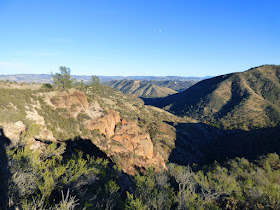Sunday, December 6, 2015
I've Been Under, Over, and On a Volcano. Now Let's Go Into a Volcano
Being on a volcano isn't too bad,at least if it isn't erupting. In Hawaii, I've even enjoyed being on an erupting volcano. "On" isn't too hard as a rule. You just drive or walk on it. Being over a volcano takes a little aerial technology, but flying to Seattle on a clear day does the trick. I've occasionally posted aerial shots of the Cascades volcanoes.
Getting under a volcano is a bit trickier. One needs to find a place where the magma chambers feeding a volcano have cooled and solidified, and then wait a few tens of millions of years while the crust rises and is stripped away by erosion. The exposed rocks would include granite, granodiorite, tonalite, and diorite. There are some very nice places to see such rocks, especially in my backyard, at Yosemite, Sequoia, and Kings Canyon National Parks in the Sierra Nevada. Needless to say, I've written just a little bit about these places...
Getting into a volcano is pretty much like getting underneath one. It takes less time, since only thousands of feet of erosion are needed, instead of miles. The trick is finding an accessible deeply eroded volcano. One of the most scenic of all eroded volcanoes has to be the half volcano of Pinnacles National Park in California's Coast Ranges. I don't mean "half" in the sense of half eroded away. Half of the volcano is missing for other reasons (read on...).
We took our last official field trip of the semester a few weeks back, and our destination was Pinnacles, being our nation's national park, and one of the most scenic and geologically interesting parts of the Coast Ranges (although there are many things that are geologically interesting about the Coast Ranges). Of course, as is my wont, I lectured and talked about the geology, but no lecture can ever compete with field experience. I sent the students up the trails to see the geology up close.
I headed up the Condor Gulch Trail. It connects after 1.7 miles with the High Peaks Trail, which is one of the finest short hikes in North America. My heart was there, but not the time. I made for the Condor Gulch Overlook, and continued another half mile to gain some wonderful views of the surrounding territory.
The volcano at Pinnacles National Park was a composite cone with at least five vents or domes composed of rhyolite lava and breccias. I imagine the closest analog to the volcano in California today wold be Mammoth Mountain in the eastern Sierra Nevada, although Pinnacles was situated much closer to the ocean, and may have been partly under water. Most of the rocks exposed along the trail began as mudflows on the flanks of the volcano, the summit of which was located a couple of miles south of the trail I was following.
From the Condor Gulch Overlook, one can look into a series of potholes where the intermittent stream flows over the volcanic bedrock. Boulders in the swirling currents have eroded the holes, which may hold water for weeks or months after major storms. The water is can be critical for wildlife in the area.
The Pinnacles volcano erupted near the newly forming San Andreas fault system, and the volcano was actually split in half by the fault motions. One part of it remained in southern California where the exposures are called the Neenach Volcanics. They can be seen in the Lancaster area quite close to the Antelope Valley Poppy Preserve. The rocks on the other side of the fault were carried north some 195 miles (314 kilometers) over 23 million years. It wasn't wasn't fast...maybe 2 inches per year, but the manner in which it happened was pretty violent. Every century or so there would be an earthquake in the range of magnitude 7.5-8.0 that moved the fault 10-20 feet all at once. The process continues today, with the San Francisco earthquake of 1906, the Fort Tejon earthquake of 1857, and the Loma Prieta earthquake of 1989. Enough stress is built up on various segments of the faults to produce large and damaging earthquakes, events that California needs to be prepared for.
From the ridgetop, the landscape appears gentle and serene. The thick brush and Gray Pines hide evidence of a violent past: volcanic eruptions, earthquakes, mudflows, and landslides. Today, the park is a delightful place to explore, with 30 miles of trails. I certainly enjoyed the three miles I traveled the other day.
If you are having trouble visualizing what 195 miles looks like, check out the fault map below that shows the location of the San Andreas, the Pinnacles volcano, and the Neenach volcanics.











No comments:
Post a Comment